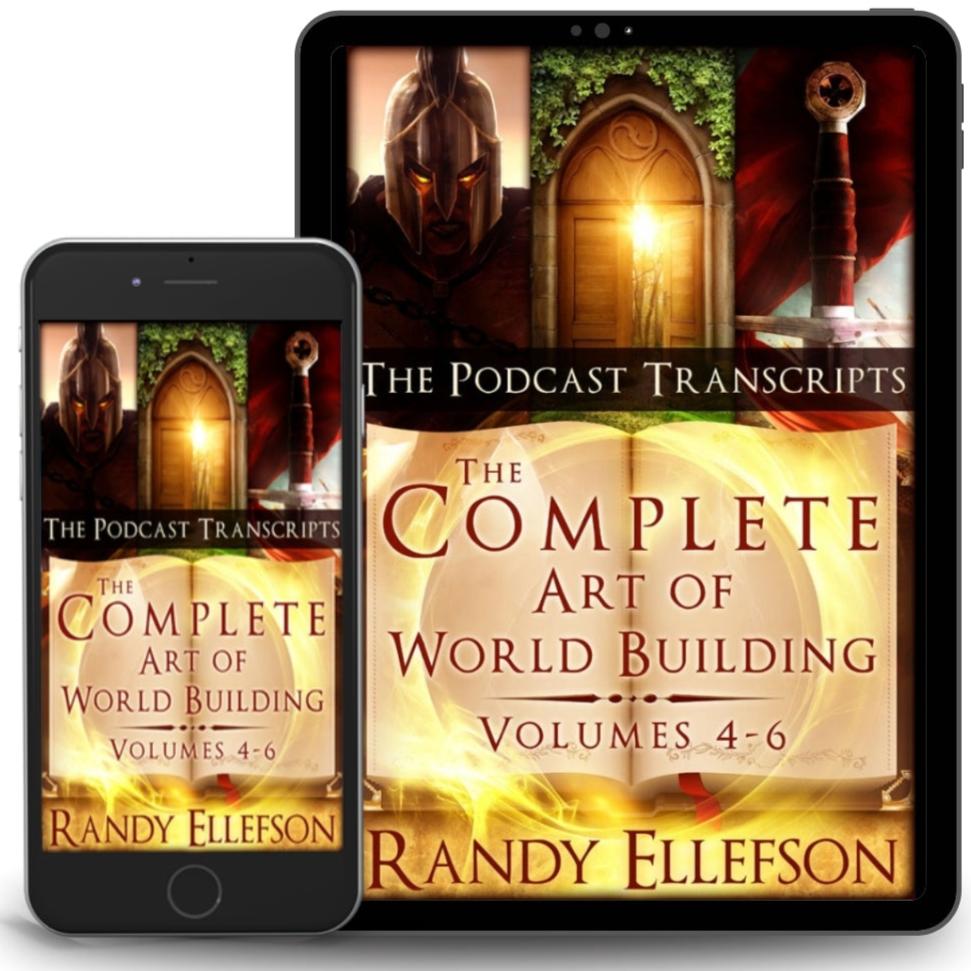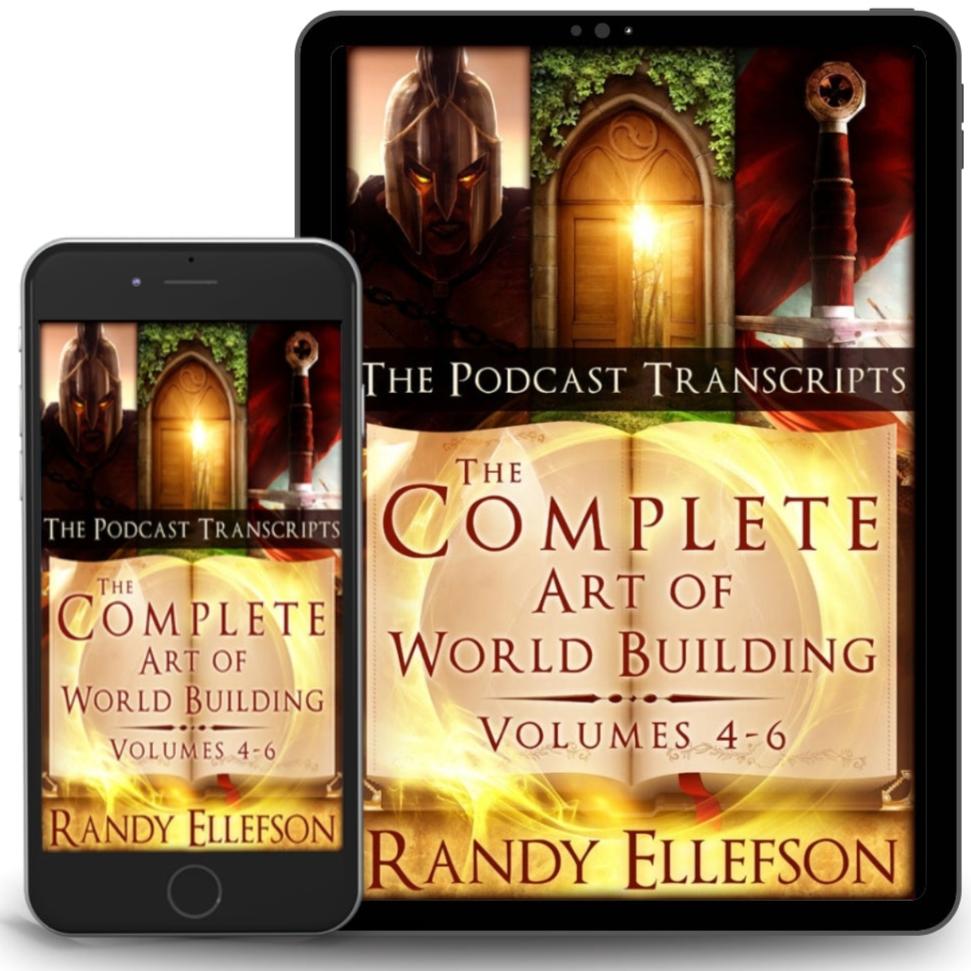The Complete Art of World Building Podcast Transcripts (eBook)
The Complete Art of World Building Podcast Transcripts (eBook)
Learning to create a unique, immersive setting one podcast episode at a time.
A guide for authors, gamers, and hobbyists.
World building strategist Randy Ellefson turned his successful book series, The Art of World Building, into a popular podcast, with episodes loosely drawn from each book in the series. The Complete Art of World Building Podcast Transcripts brings together every episode, previously only available in volumes 4-6.
More improvisational and freewheeling than the books, the episodes delve into more details about everything. From Creating Life, he discusses gods, species/races, plants, animals, monsters, heroes, villains, and even the undead. From Creating Places, he covers how to invent planets, continents, sovereign powers, settlements, history, maps, and more. From Cultures and Beyond, he examines inventing names, organizations, armed forces, cultures, and more, including magic, educational, legal, communication, and health systems.
No other world building podcast provides transcripts you can take with you.
Build better, faster.
Couldn't load pickup availability
Share

Product Details
FAQs: How Will I Get My eBook?
eBooks are delivered instantly by link in your confirmation email (and as a backup, also by email from our delivery partner, BookFunnel).
FAQs: How Do I Read My eBook?
You can read the eBooks on any e-reader (amazon, Kobo, Nook), your tablet, phone, computer, and/or in the free BookFunnel app.
Read a Sample
Episode 21 Part 1 - How to Create Cultures
Defining Culture
To get started, we should have a good idea of what culture is. Most of us have some idea, but, at the same time, we’re also kind of vague about that. So, let’s get specific.
One way of looking at culture is that it is the lifestyle for a social group, and that social group could be anything. On Earth it could be Christians, another religion, metal heads, punk rockers, nerds, jocks or pretty much anything. Each one of these groups has its own culture. At the same time, they belong to a larger culture. So, we could have all of the groups I just mentioned living in the United States, which has a sort of broader culture that encompasses all of those. You can think of this as a culture scope. And when we are trying to invent culture, we should figure out what scope are we inventing it for. Am I just creating something for a little group like the metal heads, or am I creating a culture for a region or a country?
Culture is also a set of expectations about how people are supposed to behave. Anytime we have a culture clash between one character and others, what’s usually happening is those expectations are not being met. Anytime an expectation is not met, that usually causes a negative reaction. That negative reaction causes some emotions, and it also causes judgment about the person who is not meeting our expectations — whether those judgments are fair or not. A simple example would be that if you’re driving a car in the United States, you’re on the highway and you’re going to turn off, you’re supposed to use your turn signal. That’s what our expectation is. That’s part of our culture. So, if someone doesn’t do it, you’re behind them and you don’t understand why they’re slowing down, and then, at the last second, they suddenly turn off the road, sometimes we get angry that they were rude to us by not letting us know what they were planning to do. At its simplest level, this is basically what culture is.
Culture Origins
The next question, then, becomes, “Where do these expectations come from?” The answer is basically values, beliefs and morals. These are what we might call the origins of culture, and they manifest in specific ideas. For example, if the value is being polite to people, then in the example about the car driver, they weren’t being polite to us, or they weren’t being courteous. And if courteousness is a value, then they have offended that value. The important point here is that we’ve got the points of origin, which are these values, beliefs and morals, and then we have the manifestations. To some extent, they really do come in that order, and that’s the order that we’re going to talk about them today.
In other words, when we are trying to invent a culture, we should start with those beliefs, values and morals, and then work on how they manifest.
That’s not to say that we can’t think of specific issues that are happening, the specific manifestations, but we always need to have some idea of what the original source is, otherwise we might be creating cultural aspects that conflict with each other. I think of that as cultural vision, and we’ll talk more about that in a few minutes.
So, let’s take a look at the points of origin for a culture. As we get started here, I want you to think about a kind of hierarchy where culture might exist at the sovereign power level, such as a kingdom, and then at the regional level within that kingdom, and then the settlements within that, and then within there you would have different social groups. That said, those social groups can exist across different settlements and regions. One reason we want to think of it this way is that there is a kind of inheritance from the larger picture, like the sovereign power level, all the way down to that small social group.
One reason to think of it this way is that we may want to focus first on the government type that this place has. Why does this matter? Well, a democracy is going to have a very different set of ideas that are being promoted by that government versus a totalitarian dictatorship. In Episode 14, which was actually three different episodes (14.1, 14.2, 14.3), we discussed in some detail the different types of sovereign powers. So, I’m not going to rehash those de-tails, but I want you to pay attention to that hierarchy when you are starting to create a culture.
Table of Contents
Episodes Included
1: Intro to the Podcast
2: How to Use Analogues
3: How Many Worlds to Build
4.1 and 4.2: How to Create Gods and Pantheons
5.1, 5.2, 5.3: How to Create Species and Races
6: How to Create World Figures
7: How to Create Monsters
8: How to Create Plants
9: How to Create Animals
10.1 and 10.2: How to Create Undead
22: Assign Senses to Species11.1 and 11.2: How to Create Planets
12: How to Create a Continent
13.1 and 13.2: How to Create Land Features
14.1, 14.2, and 14.3: How to Create Sovereign Powers
15.1 and 15.2: How to Create Settlements
16: Travel Over Land
17: Travel Over Water
18: Travel In Space
19: Create Time & History
20: Create Places of Interest
21: How To Create Maps
23: Creating Names
24: Organizations
25: Armed Forces
26: Religions
27.1-27.4: Cultures
28: Languages
29: The Supernatural
30: Items
31.1, 31.2: Magic Systems
32: Other Systems
33: Conclusion
Availability at Retailers
It’s financially beneficial to any artist to buy directly from them, but this product may be available at these retailers.

